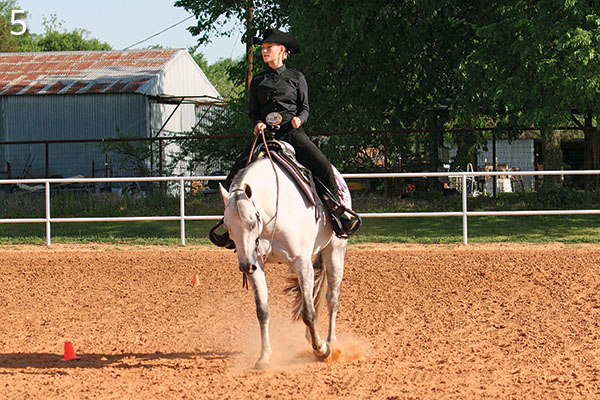It might look like a simple drill—riding a square around four cones. But you’d be surprised how hard it is to maintain a consistent distance from each cone, make a square or rounded corner, and travel a straight line to the next marker. This drill is a fundamental part of our program because it allows us to evaluate a rider’s skill and attention to detail. It also teaches the rider about pattern placement and planning for each step of a pattern. Not so simple after all!
Here, we’ll discuss how we use this square, which consists of four cones set in a square 15 to 30 paces apart, depending on the size of the arena. Our rider will work the square to the right; reverse all cues to ride the square to the left. Once you feel comfortable with this drill—traveling from cone to cone to complete the square—challenge yourself further by adding gait transitions, stops, and spins at the markers or where your trainer or helper calls for them. It’ll reveal just how much more you have to learn.
1. Every corner in this exercise has an approach, a turn, and an exit. While you might tend to focus on the corners—we’re all drawn to the cones—it’s the approach and the exit that can make or break each turn. Before you start, think about how your body’s position on your horse influences his direction. A shift in weight might seem inconsequential to you, but it can seem like a much “bigger cue” to your horse. Begin by walking around the square’s perimeter, and then work up to a jog, like this rider. Pay close attention to your straightness in the saddle and your horse’s straight path as you approach the first cone. Note how our rider looks ahead with square shoulders, balancing her seat in the middle of her saddle. This approach will help her as she executes her first corner at the cone.

2. As she comes around the corner, our rider continues facing her approach path, but she steers her horse around the corner. The rider exaggerates her body positon here, leading more obviously with her right shoulder, for photo purposes. This delay in changing her body position means that she can hold her horse off the cone to prevent him from diving into the turn. Her cues combine to say “turn here, but not so much that you cut the corner and we start down a path to the cone diagonal from us.”

3. Now that her horse is mostly through the corner, our rider squares up her position to set her horse on a straight path. The correctness of this exit from the corner helps encourage that straightness in her horse. The key is to avoid over- or under-turning your body as you go through the corner. This will help you keep your horse on the correct line of travel.

4. Notice the distance between the horse and the markers. Our rider’s a little farther off the cones than we’d typically like to see, but if she keeps an even, comfortable distance all the way around, it’s acceptable. If she guides her horse too close to the markers, she’ll have a hard time making correct corners. Her horse would have to dive into each turn, which can set up problems. If she stays even farther away from the cones than she is, she’s more likely to get lazy and round her corners and not make a precise square corner.

5. From this angle, as our rider steers her horse into the next corner, you can see her body’s straightness while she begins to turn right. This encourages forward motion in her horse and keeps him from turning too sharply. As she continues through her turn, her body will rotate accordingly through the corner. She’ll straighten her torso to align with her horse’s straight path as she exits the turn.

6. Once she’s proficient at corners, we can call out commands based on the cones. Here we asked our rider to extend the trot between two cones. This means that the next marker will come up quicker than at a walk or jog, so she’d better be prepared. She’ll refine her timing for the turn and gain precision in her cues by working in an extended stride. We keep her on her toes by calling for a stop and spin at a cone, or asking her to take a diagonal path between the diagonal cones. This gets her thinking and keeps her horse guessing.

Will and Elizabeth Knabenshue, Whitesboro, Texas, grew up showing horses on opposite coasts—Will in Virginia and Elizabeth in California. The two now train all-around horses and coach amateur and youth riders. Will is an AQHA and NSBA judge. Elizabeth is an AQHA World Champion and multiple All American Quarter Horse Congress champion. The couple has trained and coached numerous amateur and youth world champions.






